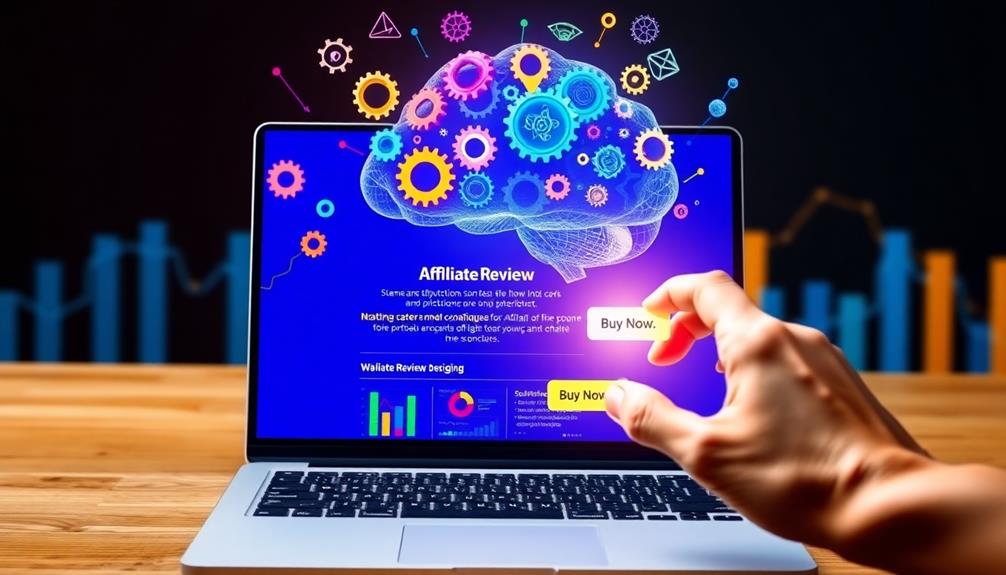To write affiliate reviews that sell, you need to harness the power of NLP techniques to connect with your audience. Focus on understanding their motivations by using sensory language and engaging metaphors. Build rapport by actively listening and mirroring their communication style. Address objections with empathy and reinforce your points with testimonials. Create urgency with compelling calls to action. Remember, tapping into emotions and visualizing benefits can greatly boost conversions. It's all about aligning your message with your readers' desires. Keep going, and you'll uncover more strategies to elevate your affiliate marketing game.
Key Takeaways
- Utilize sensory language to evoke emotions and create vivid imagery that resonates with readers' desires and aspirations.
- Apply storytelling techniques to connect with prospects on an emotional level, addressing their pain points and building empathy.
- Use metaphors to simplify complex product benefits, making them relatable and enhancing emotional connections with the audience.
- Incorporate open-ended questions in your reviews to uncover deeper motivations and align your offerings with buyer values.
- Craft clear, actionable calls to action that create urgency and encourage immediate responses from potential buyers.
Understanding NLP in Sales

Understanding NLP in sales can transform your approach to connecting with customers. By using Neuro-Linguistic Programming techniques, you can enhance your selling skills and greatly boost your conversion rate.
NLP focuses on language patterns and psychological techniques that influence buyer behavior, making it an invaluable tool in your sales arsenal. Incorporating elements of motivation for success can further enhance your ability to engage with clients and drive results.
Techniques like mirroring, reframing, and building rapport are foundational to NLP. They help you connect with prospects on a deeper level and understand their needs more effectively. For instance, by asking targeted questions like, "What brings you in here today?" you can elicit buying patterns and values that align with your sales presentations.
Research shows that many sales professionals have reported impressive increases in their performance after incorporating NLP strategies. Some even claim to have nearly doubled their results!
While NLP can also be applied in written communications, mastering these techniques requires practice and a good grasp of their nuances.
Identifying Prospect Motivations

To sell effectively, you need to uncover your prospects' immediate desires and understand their buying criteria.
By aligning your values with their needs, you can create a powerful connection that drives conversions.
For instance, understanding the importance of Gold IRA fees can help you address concerns related to investment costs.
Let's explore how identifying these motivations can elevate your affiliate marketing strategy.
Uncovering Immediate Desires
While you might think that product features are what drive purchases, uncovering immediate desires often reveals deeper motivations that can greatly influence your prospects. By asking targeted questions like "What brings you in here today?" you can identify emotional triggers and tailor your affiliate review accordingly. This approach resonates with your target audience, leading to higher conversion rates.
To enhance your reviews, consider the following aspects of immediate desires:
| Aspect | Description | Example |
|---|---|---|
| Emotional Triggers | Feelings that prompt purchases | Safety, happiness, excitement |
| Sensory Language | Language that appeals to the senses | "Imagine the soft touch of…" |
| Preferred Modalities | Visual, auditory, or kinaesthetic | "Listen to the soothing sounds…" |
Practicing active listening and responding to feedback can uncover hidden motivations. When you align your reviews with these immediate desires, you create a more engaging experience, making your audience feel seen and understood. This connection can ultimately drive them to take action and make a purchase.
Understanding Buying Criteria
When it comes to making a purchase, knowing what drives your prospects' decisions can make all the difference. Identifying their buying criteria is essential for understanding their motivations during the purchasing process. Start by asking direct questions like, "What brings you in here today?" This helps uncover the immediate factors guiding their decision-making.
As you navigate these conversations, consider the importance of open communication for conflict resolution to better understand any reservations they may have.
To effectively engage prospects, recognize their sensory modalities—whether they prefer visual, auditory, or kinaesthetic information. Tailoring your communication style to match their preferences enhances engagement and persuasion.
Establishing rapport can greatly influence their likelihood of making a purchase; research shows that connecting with buyer motivations can nearly double your sales performance when using NLP techniques.
As you gather insights into your prospects' values and criteria, align your sales presentations accordingly. When prospects see that their needs and preferences are being addressed, the chances of closing a sale increase dramatically.
Keep these principles in mind to create a compelling narrative that resonates with your audience, ensuring they feel understood and valued throughout their decision-making journey. In doing so, you'll position yourself as a trusted advisor rather than just a salesperson.
Aligning Values and Needs
Aligning values and needs is essential for understanding what truly drives your prospects. To effectively identify their motivations, consider asking open-ended questions like, "What brings you in here today?" This approach not only reveals immediate needs but also uncovers deeper values, enhancing your ability to persuade.
Here are four key aspects to focus on:
- Empathy: Show you genuinely care about their needs, which builds trust.
- Buyer Criteria: Identify what they value most, so you can tailor your offerings accordingly.
- Active Listening: Reflect back key points they mention to confirm their motivations are acknowledged.
- Long-term Goals: Understand their aspirations to align your solutions with their future vision.
Building Rapport Effectively

Building rapport effectively is essential in sales, as it creates a bridge of trust and connection between you and your prospect. When you focus on building rapport, you increase the likelihood of conversion by making your prospects feel understood and valued.
One powerful technique is active listening; by truly hearing what your prospect says, you demonstrate that their opinions matter.
Additionally, employing matching and mirroring can enhance this connection. By subtly reflecting their body language and tone, you can create a sense of familiarity that makes them more comfortable with you.
It's also important to use language patterns tailored to your prospect's preferred communication style—whether they're visual, auditory, or kinaesthetic.
Establishing common ground through shared experiences or interests helps deepen this connection, making your prospect more receptive to your message.
Furthermore, continuously calibrating your responses based on their feedback allows for dynamic adjustments in the conversation, ensuring a personalized rapport-building experience.
Utilizing Metaphors in Reviews

Metaphors can be your secret weapon in affiliate reviews, turning complex product benefits into relatable concepts.
By painting vivid pictures, you enhance emotional connections, making it easier for your audience to visualize owning the product.
When you tap into their experiences and aspirations, you're not just selling a product; you're selling a lifestyle.
Simplifying Complex Concepts
When you're trying to convey the benefits of a product, using metaphors can transform complex concepts into accessible ideas that resonate with your audience. By simplifying information, you help potential customers visualize the product's value, making it easier for them to understand.
Here's how metaphors can enhance your reviews:
- Create relatable imagery: Metaphors turn abstract ideas into familiar experiences, making them more digestible.
- Reduce cognitive resistance: They allow readers to grasp difficult concepts without feeling overwhelmed or confused.
- Guide decision-making: Phrases like "navigating a maze" illustrate how the product can help users overcome challenges effortlessly.
- Boost memory retention: Research shows that engaging metaphors increase the likelihood that key benefits will stick in readers' minds.
Enhancing Emotional Connection
Crafting a compelling review isn't just about listing features; it's about forging an emotional connection with your readers. By using metaphors, you can simplify complex ideas and help your audience relate to the benefits of buying a product. For instance, comparing a high-speed blender to a "race car for your kitchen" makes it easier for potential buyers to visualize its capabilities and excitement.
Effective metaphors can bypass conscious resistance, allowing the emotional impact of a product to resonate more deeply. When you say that using a new planner is like "planting a seed" for personal growth, you evoke feelings of hope and transformation, encouraging readers to see the long-term benefits in a relatable way.
Short, vivid metaphors create memorable images, enhancing the persuasive power of your review. When these metaphors align with your target audience's values and experiences, you greatly improve rapport and deepen that emotional connection.
Ultimately, when your readers feel a connection through your words, they're more likely to take action and make a purchase, transforming your review from mere text into a powerful selling tool.
Visualizing Ownership Benefits
Building on the emotional connections you've established, visualizing ownership benefits can greatly influence a buyer's decision.
By using NLP and metaphors, you can help potential buyers see the true value of what they're considering. Here's how to effectively evoke emotion:
- Freedom: Compare a high-performance motorbike to the thrill of riding on an open road. It's not just a bike; it's freedom.
- Warmth: Describe a luxurious skincare product as a "daily dose of sunshine for your skin," allowing them to feel the warmth and positivity it brings.
- Adventure: Frame an outdoor gear product as the key to revealing their next great adventure, making it feel essential to their dreams.
- Connection: Portray a tech gadget as a bridge to connect with loved ones, emphasizing its role in fostering relationships.
Overcoming Objections Skillfully

While you may encounter potential objections from your audience, addressing these concerns head-on can greatly enhance your credibility.
Start by proactively acknowledging common issues, like price or usability. Use factual information and testimonials to reinforce the product's value. Employ the "feel, felt, found" technique to show empathy. Share relatable stories of past customers who had similar hesitations but ultimately found satisfaction after their purchase.
Incorporating social proof is essential. Include testimonials and case studies that directly counter specific objections, strengthening your argument. When potential buyers see others benefiting, their trust in the product grows.
Additionally, create a sense of urgency by highlighting limited-time offers or exclusive bonuses. This helps alleviate decision-making paralysis, prompting immediate action.
Make sure to clearly outline customer support options and satisfaction guarantees, reassuring your audience that help is available if needed post-purchase.
Ultimately, every time you address objections, you're not just overcoming barriers; you're building trust. By skillfully addressing concerns, you can effectively guide your audience toward making a confident purchasing decision.
Don't forget to include a strong call to action to encourage them to take the next step!
Engaging Sensory Language

Engaging sensory language can transform your affiliate reviews into compelling narratives that resonate with readers on multiple levels. By tapping into their preferred sensory modalities—visual, auditory, and kinaesthetic—you create a more immersive experience that enhances persuasion.
Here's how to evoke emotion effectively:
- Visual: "Can you see how this will improve your life?" This invites readers to visualize the benefits vividly.
- Auditory: "Imagine hearing the satisfaction in your friend's voice when they use this product." This engages the reader's imagination, making the experience relatable.
- Kinaesthetic: "Feel the comfort of using this product daily." This helps readers connect emotionally by relating to physical sensations.
- Vivid Imagery: Use descriptive language to paint a mental picture for your audience, enhancing their understanding and retention.
Incorporating these elements of engaging sensory language not only captures attention but also builds a stronger connection, increasing the likelihood that your readers will take action.
Emotional Influence Techniques

Emotions drive decisions, making emotional influence techniques essential in crafting compelling affiliate reviews. When you use storytelling, it evokes emotional responses that can boost purchase intent by 22%. By weaving narratives that resonate with your audience, you make the product's benefits relatable and memorable.
Incorporating vivid imagery and metaphors helps simplify complex ideas, allowing readers to visualize the product's impact on their lives. This fosters a deeper emotional connection, making your review not just informative but also engaging.
Additionally, acknowledging your readers' pain points and presenting the product as a solution builds trust. When you show empathy, you resonate with your audience's struggles, leading to a 30% higher likelihood of conversion.
Don't underestimate the principle of reciprocity; by offering valuable insights or free resources, you encourage readers to feel compelled to reciprocate, often through a purchase.
Attention-Grabbing Strategies

To capture your audience's attention effectively, incorporating unexpected language or surprising references can be a game-changer.
By disrupting their thought patterns, you'll draw them into your affiliate reviews and enhance engagement.
Here are four attention-grabbing strategies you can use:
- Start with a provocative question: Pose a question that resonates with your audience's needs or challenges.
- Use intriguing statistics: Share surprising data that highlights the product's effectiveness, making readers curious.
- Incorporate sensory language: Use vivid imagery and auditory cues to create a sensory experience that connects emotionally with your audience.
- Tell engaging stories: Weave in narratives that reflect your clients' aspirations and include relatable scenarios, making your product relatable.
Crafting Compelling Calls to Action

While crafting compelling calls to action (CTAs) might seem straightforward, the difference between a mediocre response and a phenomenal conversion often lies in the details. You need to create effective calls to action that are clear and concise.
Use actionable language like "Buy Now" or "Get Started Today" to prompt immediate responses. Incorporating urgency can also make a significant impact. Phrases like "Limited Time Offer!" or "Only a Few Left!" encourage readers to take action quickly, boosting your conversion rates.
Personalization is key—referencing the reader's name or specific needs can forge a stronger connection and enhance engagement.
Additionally, pay attention to the visual aspects. Using contrasting colors for your CTA buttons will draw attention and improve click-through rates. Remember, visual cues are essential in guiding user behavior.
Frequently Asked Questions
How to Use NLP for Persuasion?
To use NLP for persuasion, you'll want to connect emotionally, employ sensory language, and build rapport. Storytelling and ethical practices enhance your credibility, making your message more relatable and compelling for your audience.
How to Use NLP in Sales?
To use NLP in sales, focus on building rapport, understanding your prospect's motivations, and tailoring your message. Utilize sensory language, storytelling, and probing questions to engage effectively and make your offerings more relatable and appealing.
Conclusion
Incorporating NLP techniques into your affiliate reviews can greatly boost your sales potential. Research shows that 93% of communication effectiveness is determined by nonverbal cues and tone, highlighting the importance of emotional influence and rapport-building. By understanding your prospects' motivations and using sensory language, you can create compelling narratives that resonate with them. Remember, a well-crafted call to action can be the difference between a casual reader and a committed buyer. Start applying these strategies today!










